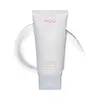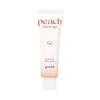What's inside
What's inside
 Key Ingredients
Key Ingredients

 Benefits
Benefits

 Concerns
Concerns

 Ingredients Side-by-side
Ingredients Side-by-side

Water
Skin ConditioningCyclopentasiloxane
EmollientButylene Glycol
HumectantCyclohexasiloxane
EmollientTitanium Dioxide
Cosmetic Colorant1,2-Hexanediol
Skin ConditioningNiacinamide
SmoothingCetyl PEG/PPG-10/1 Dimethicone
EmulsifyingDimethicone
EmollientTocopheryl Acetate
AntioxidantCentella Asiatica Extract
CleansingLavandula Angustifolia Flower Water
Skin ConditioningSalvia Sclarea Extract
AntiseborrhoeicHelianthus Annuus Extract
EmollientChamomilla Recutita Extract
Skin ConditioningBorago Officinalis Extract
EmollientCentaurea Cyanus Flower Extract
AstringentGlutathione
Sodium Hyaluronate
HumectantPolyglutamic Acid
Skin ConditioningHydrolyzed Hyaluronic Acid
HumectantHydroxypropyltrimonium Hyaluronate
Sodium Hyaluronate Crosspolymer
HumectantSodium Acetylated Hyaluronate
HumectantSodium Chloride
MaskingDimethicone/Vinyl Dimethicone Crosspolymer
Skin ConditioningAluminum Hydroxide
EmollientTriethoxycaprylylsilane
Parfum
MaskingDisodium EDTA
Dipotassium Glycyrrhizate
HumectantEthylhexylglycerin
Skin ConditioningPentylene Glycol
Skin ConditioningWater, Cyclopentasiloxane, Butylene Glycol, Cyclohexasiloxane, Titanium Dioxide, 1,2-Hexanediol, Niacinamide, Cetyl PEG/PPG-10/1 Dimethicone, Dimethicone, Tocopheryl Acetate, Centella Asiatica Extract, Lavandula Angustifolia Flower Water, Salvia Sclarea Extract, Helianthus Annuus Extract, Chamomilla Recutita Extract, Borago Officinalis Extract, Centaurea Cyanus Flower Extract, Glutathione, Sodium Hyaluronate, Polyglutamic Acid, Hydrolyzed Hyaluronic Acid, Hydroxypropyltrimonium Hyaluronate, Sodium Hyaluronate Crosspolymer, Sodium Acetylated Hyaluronate, Sodium Chloride, Dimethicone/Vinyl Dimethicone Crosspolymer, Aluminum Hydroxide, Triethoxycaprylylsilane, Parfum, Disodium EDTA, Dipotassium Glycyrrhizate, Ethylhexylglycerin, Pentylene Glycol
Water
Skin ConditioningPrunus Mume Flower Water
Skin ConditioningDipropylene Glycol
HumectantHydrogenated Polydecene
EmollientBetaine
HumectantTitanium Dioxide
Cosmetic ColorantNiacinamide
SmoothingGlycerin
HumectantPanthenol
Skin ConditioningGlyceryl Stearate Citrate
EmollientSodium Polyacryloyldimethyl Taurate
Emulsion StabilisingCandida Bombicola/Glucose/Methyl Rapeseedate Ferment
AntimicrobialPropanediol
SolventPolyglyceryl-3 Stearate
Emulsifying1,2-Hexanediol
Skin ConditioningHydrogenated Lecithin
EmulsifyingCanola Oil
EmollientLimnanthes Alba Seed Oil
Skin ConditioningHelianthus Annuus Seed Oil
EmollientSodium Acrylate/Sodium Acryloyldimethyl Taurate Copolymer
Emulsion StabilisingGlyceryl Caprylate
EmollientZinc Stearate
Cosmetic ColorantPolyisobutene
Argania Spinosa Kernel Oil
EmollientEthylhexylglycerin
Skin ConditioningPolyglyceryl-10 Stearate
Skin ConditioningJasminum Officinale Flower Water
MaskingCaprylyl/Capryl Glucoside
CleansingButylene Glycol
HumectantDioscorea Japonica Root Extract
Skin ConditioningRosa Damascena Flower Water
MaskingCymbopogon Nardus Oil
MaskingSodium Phytate
Sorbitan Oleate
EmulsifyingPrunus Persica Fruit Extract
AbrasiveVanilla Planifolia Fruit Extract
Skin ConditioningCitric Acid
BufferingHydrolyzed Corn Starch
HumectantBiosaccharide Gum-1
HumectantBeta-Glucan
Skin ConditioningSucrose
HumectantTocopherol
AntioxidantGlutathione
Prunus Persica Flower Extract
MoisturisingWater, Prunus Mume Flower Water, Dipropylene Glycol, Hydrogenated Polydecene, Betaine, Titanium Dioxide, Niacinamide, Glycerin, Panthenol, Glyceryl Stearate Citrate, Sodium Polyacryloyldimethyl Taurate, Candida Bombicola/Glucose/Methyl Rapeseedate Ferment, Propanediol, Polyglyceryl-3 Stearate, 1,2-Hexanediol, Hydrogenated Lecithin, Canola Oil, Limnanthes Alba Seed Oil, Helianthus Annuus Seed Oil, Sodium Acrylate/Sodium Acryloyldimethyl Taurate Copolymer, Glyceryl Caprylate, Zinc Stearate, Polyisobutene, Argania Spinosa Kernel Oil, Ethylhexylglycerin, Polyglyceryl-10 Stearate, Jasminum Officinale Flower Water, Caprylyl/Capryl Glucoside, Butylene Glycol, Dioscorea Japonica Root Extract, Rosa Damascena Flower Water, Cymbopogon Nardus Oil, Sodium Phytate, Sorbitan Oleate, Prunus Persica Fruit Extract, Vanilla Planifolia Fruit Extract, Citric Acid, Hydrolyzed Corn Starch, Biosaccharide Gum-1, Beta-Glucan, Sucrose, Tocopherol, Glutathione, Prunus Persica Flower Extract
Ingredients Explained
These ingredients are found in both products.
Ingredients higher up in an ingredient list are typically present in a larger amount.
1,2-Hexanediol is a synthetic liquid and another multi-functional powerhouse.
It is a:
- Humectant, drawing moisture into the skin
- Emollient, helping to soften skin
- Solvent, dispersing and stabilizing formulas
- Preservative booster, enhancing the antimicrobial activity of other preservatives
Butylene Glycol (or BG) is used within cosmetic products for a few different reasons:
Overall, Butylene Glycol is a safe and well-rounded ingredient that works well with other ingredients.
Though this ingredient works well with most skin types, some people with sensitive skin may experience a reaction such as allergic rashes, closed comedones, or itchiness.
Learn more about Butylene GlycolEthylhexylglycerin (we can't pronounce this either) is commonly used as a preservative and skin softener. It is derived from glyceryl.
You might see Ethylhexylglycerin often paired with other preservatives such as phenoxyethanol. Ethylhexylglycerin has been found to increase the effectiveness of these other preservatives.
Glutathione is an antioxidant naturally found in our bodies. It is made up of three amino acids: glycine, cysteine, and glutamic acid.
As an antioxidant, it prevents oxidative damage to parts of our cell.
While glutathione is said to help with fading dark spots, the results from research are inconclusive. Further studies are needed. With that said, gluthatione has been shown to protect our skin from UV-B induced damage.
This ingredient is naturally occurring in plants, animals, fungi, and some bacteria.
Learn more about GlutathioneNiacinamide is a multitasking form of vitamin B3 that strengthens the skin barrier, reduces pores and dark spots, regulates oil, and improves signs of aging.
And the best part? It's gentle and well-tolerated by most skin types, including sensitive and reactive skin.
You might have heard of "niacin flush", or the reddening of skin that causes itchiness. Niacinamide has not been found to cause this.
In very rare cases, some individuals may not be able to tolerate niacinamide at all or experience an allergic reaction to it.
If you are experiencing flaking, irritation, and dryness with this ingredient, be sure to double check all your products as this ingredient can be found in all categories of skincare.
When incorporating niacinamide into your routine, look out for concentration amounts. Typically, 5% niacinamide provides benefits such as fading dark spots. However, if you have sensitive skin, it is better to begin with a smaller concentration.
When you apply niacinamide to your skin, your body converts it into nicotinamide adenine dinucleotide (NAD). NAD is an essential coenzyme that is already found in your cells as "fuel" and powers countless biological processes.
In your skin, NAD helps repair cell damage, produce new healthy cells, support collagen production, strengthen the skin barrier, and fight environmental stressors (like UV and pollution).
Our natural NAD levels start to decline with age, leading to slower skin repair, visible aging, and a weaker skin barrier. By providing your skin niacinamide, you're recharging your skin's NAD levels. This leads to stronger, healthier, and younger looking skin.
Another name for vitamin B3 is nicotinamide. This vitamin is water-soluble and our bodies don't store it. We obtain Vitamin B3 from either food or skincare. Meat, fish, wheat, yeast, and leafy greens contain vitamin B3.
The type of niacinamide used in skincare is synthetically created.
Learn more about NiacinamideTitanium dioxide is a mineral UV filter widely used in sunscreens and cosmetics.
It is one of only two UV filters officially classified as “mineral” by regulatory agencies, the other being zinc oxide.
Titanium dioxide provides broad-spectrum protection mostly in the UVB and UVAII range, with some protection in the UVAI range.
While its UVA protection isn’t as strong as zinc oxide’s, the difference is minor.
A common myth is that mineral UV filters reflect UV light. However, modern research shows titanium dioxide absorbs UV radiation like chemical filters (~95% absorption & 5% reflection).
Thanks to its non-irritating nature, titanium dioxide is suitable for sensitive, acne-prone, or redness-prone skin. It is unlikely to cause "eye sting" like other sunscreen ingredients.
A major drawback of this ingredient is its white cast and thick texture. This is why mineral sunscreens often leave a white cast and are less cosmetically elegant than chemical/hybrid sunscreens.
To improve white cast and spreadability, micronized or nano-sized titanium dioxide is often used.
There are ongoing concerns surrounding nano-titanium oxide's impact on marine ecosystems.
There is no conclusive evidence that any form of titanium oxide (or any other sunscreen ingredients) will cause harm to marine ecosystems or coral reefs. The science is still developing but many consumers are keeping a close eye on this issue.
Please note, many destinations have reef-safety sunscreen rules. For instance, the U.S. Virgin Islands advises all visitors to use non-nano mineral sunscreens.
Nano mineral sunscreens once raised safety concerns about absorption into skin.
Extensive research has shown that they do not penetrate healthy or damaged skin; they remain safely on the surface and the top layer of dead skin (stratum corneum).
You'll likely find titanium dioxide bundled with alumina, silica, or dimethicone. These ingredients help make titanium dioxide highly photostable; this prevents it from interacting with other formula components under UV light.
Learn more about Titanium DioxideWater. It's the most common cosmetic ingredient of all. You'll usually see it at the top of ingredient lists, meaning that it makes up the largest part of the product.
So why is it so popular? Water most often acts as a solvent - this means that it helps dissolve other ingredients into the formulation.
You'll also recognize water as that liquid we all need to stay alive. If you see this, drink a glass of water. Stay hydrated!
Learn more about Water